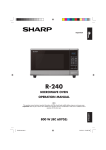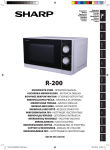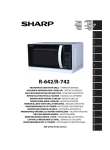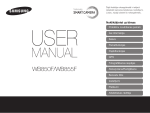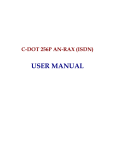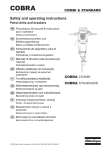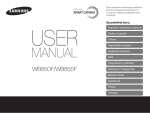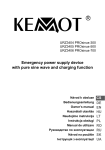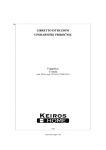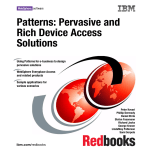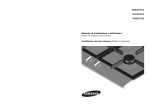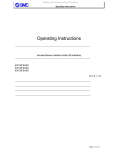Download Sharp R-240 User's Manual
Transcript
Svarīgi Svarbu Tähelepanu Важно Important Увага 800 W (IEC 60705) R-240_OM_00_FRONT_EAST.indd 1 LATVIEŠU LIETUVIŠKAI EESTI БЪЛГАРСКИ ROMÂNĂ MICROWAVE OVEN - OPERATION MANUAL ΦΟΥΡΝΟΣ ΜΙΚΡΟΚΥΜΑΤΩΝ - ΕΓΧΕΙΡΙΔΙΟ ΛΕΙΤΟΥΡΓΙΑΣ MIKROVALOVNA PEČICA - NAVODILA ZA UPORABO MIKROVLNNÁ TROUBA - NÁVOD K OBSLUZE MIKROVLNNÁ RÚRA - NÁVOD NA POUŽITIE MIKROHULLÁMÚ SÜTŐ - KEZELÉSI ÚTMUTATÓ МІКРОХВИЛЬОВА ПІЧ - ІНСТРУКЦІЯ З ЕКСПЛУАТАЦІЇ MIKROVIĻŅU KRĀSNS - LIETOŠANAS INSTRUKCIJA MIKROBANGŲ KROSNELĖ - VALDYMO VADOVAS MIKROLAINEAHI - KASUTUSJUHEND МИКРОВЪЛНОВА ФУРНА - РЪКОВОДСТВО ЗА УПОТРЕБА CUPTOR CU MICROUNDE - MANUAL DE UTILIZARE МІКРАХВАЛЕВАЯ ПЕЧ - ІНСТРУКЦЫЯ ПА ЭКСПЛУАТАЦЫІ БЕЛАРУСКАЯ R-240 УКРАЇНСЬКА MAGYAR SLOVENSKY ČESKY SLOVENŠČINA ΕΛΛΗΝΙΚΑ ENGLISH Important Σημαντικό Pomembno Důležité Dôležité Fontos Важлива інформація 2011-03-18 20:48:33 GB This operation manual contains important information which you should read carefully before using your microwave oven. Important: There may be a serious risk to health if this operation manual is not followed or if the oven is modified so that it operates with the door open. GR Αυτό το εγχειρίδιο λειτουργίας περιέχει σημαντικές πληροφορίες, τις οποίες θα πρέπει να διαβάσετε προσεκτικά πριν τη χρήση του φούρνου μικροκυμάτων. Σημαντικό: Ενδέχεται να υπάρξει σοβαρός κίνδυνος για την υγεία, αν δεν ακολουθήσετε αυτό το εγχειρίδιο λειτουργίας, ή αν τροποποιηθεί ο φούρνος έτσι ώστε να λειτουργεί με την πόρτα ανοικτή. SI V teh navodilih za uporabo najdete pomembne informacije, ki jih pred uporabo pečice pozorno preberite. Pomembno: Če teh navodil za uporabo ne upoštevate ali pečico predelate tako, da deluje z odprtimi vrati, lahko to resno škoduje vašemu zdravju. Tento návod k obsluze obsahuje důležité informace, které byste si měli pozorně přečíst před použitím této mikrovlnné trouby. Důležité: Pokud se nebude postupovat podle tohoto návodu k obsluze nebo se mikrovlnná trouba upraví tak, že bude moci pracovat s otevřenými dveřmi, může dojít k vážnému ohrožení zdraví. Tento návod na obsluhu obsahuje dôležité informácie, ktoré by ste si mali pred použitím mikrovlnnej rúry pozorne prečítať. Dôležité: Nedodržanie pokynov uvedených v tomto návode na použitie, ako aj akýkoľvek zásah, ktorý dovoľuje prevádzkovanie rúry s otvorenými dvierkami, môže viesť k závažnému poškodeniu zdravia osôb. A kezelési útmutató fontos információkat tartalmaz. Olvassa végig figyelmesen a mikrohullámú sütő használata előtt! Fontos: A jelen kezelési útmutató előírásainak be nem tartásával, illetve a mikrohullámú sütő nyitott ajtajú működését lehetővé tevő módosításával súlyos egészségkárosodási kockázatot vállal! Ця інструкція з експлуатації містить важливу інформацію, яку Вам слід уважно прочитати, перш ніж розпочати експлуатацію мікрохвильової печі. Важливо: Наслідком недотримання вказівок, наведених у цій інструкції з експлуатації, а також модифікації печі з метою її експлуатації з відчиненими дверцятами може бути серйозний ризик для здоров'я. R-240_OM_00_FRONT_EAST.indd 2 2011-03-18 20:48:41 Šī lietošanas instrukcija ietver svarīgu informāciju, kuru pirms mikroviļņu krāsns lietošanas jums vajadzētu uzmanīgi izlasīt. Svarīgi: Šīs lietošanas instrukcijas neievērošana vai krāsns pārveidošana tā, lai tā darbotos ar atvērtām durvīm, var nopietni apdraudēt veselību. Šiame valdymo vadove rasite svarbią informaciją, kurią, prieš naudodamiesi mikrobangų krosnele, turite atidžiai perskaityti. Svarbu: Jūsų sveikatai gali kilti rimtas pavojus, jei nesivadovausite šiuo valdymo vadovu ar krosnelė veiks su atidarytomis durelėmis. Käesolev juhend sisaldab olulist teawvet, mis tuleks teil enne oma mikrolaineahju kasutamist tähelepanelikult läbi lugeda. Tähtis: käesoleva juhendi eiramine või ahju muutmine selliselt, et see töötab ka avatud ukse korral, võib kujutada tervisele tõsist ohtu. Това ръководство за употреба съдържа информация, която трябва да прочетете внимателно, преди да започнете да използвате Вашата микровълнова фурна. Важно: може да има сериозен риск за здравето, ако не се спазва настоящата инструкция или фурната е преправена така, че да работи и при отворена врата. Acest manual de utilizare conţine informaţii importante, care trebuie citite cu atenţie înainte de utilizarea cuptorului cu microunde. Important: Nerespectarea instrucţiunilor descrise în acest manual sau modificarea cuptorului pentru a funcţiona cu uşa deschisă poate duce la rănirea utilizatorului. Гэтая інструкцыя па эксплуатацыі змяшчае важную інфармацыю, якую неабходна ўважліва прачытаць перад выкарыстоўваннем мікрахвалевай печы. Увага: Ваша здароўе можа падвергнуцца сур'ёзнай рызыцы, калі гэтая інструкцыя не выканоўваецца, або печ працуе з адкрытымі дзвярыма. R-240_OM_00_FRONT_EAST.indd 3 2011-03-18 20:48:41 GB Dear Customer, Congratulations on acquiring your new microwave oven, which from now on will make your kitchen chores considerably easier. You will be pleasantly surprised by the kinds of things you can do with a microwave. Not only can you use it for rapid defrosting or heating up of food, you can also prepare whole meals. There are so many advantages to having a microwave oven which we are sure you will find exciting: ● Food can be prepared directly in the serving dishes, leaving less to wash up. ● Shorter cooking times and the use of little water and fat ensure that many vitamins, minerals and characteristic flavours are preserved. We advise you to read the operating instructions carefully. You will then easily understand how to use your oven. Enjoy using your microwave oven and prepare your own favourite dishes in your microwave oven. GB-1 R-240_OM_01_EN.indd Sek1:1 2011-03-18 21:04:06 ENGLISH GB-2 R-240_OM_01_EN.indd Sek1:2 2011-03-18 21:04:11 CONTENTS Operation manual DEAR CUSTOMER ................................................................................................................................................. GB-1 INFORMATION ON PROPER DISPOSAL ............................................................................................................... GB-2 OVEN AND ACCESSORIES .................................................................................................................................... GB-4 CONTROL PANEL ................................................................................................................................................... GB-5 IMPORTANT SAFETY INSTRUCTIONS...............................................................................................................GB-6-8 INSTALLATION ....................................................................................................................................................... GB-8 BEFORE OPERATION ............................................................................................................................................. GB-9 MICROWAVE POWER LEVEL ................................................................................................................................. GB-9 MANUAL OPERATION........................................................................................................................................ GB-10 MICROWAVE COOKING ..................................................................................................................................... GB-10 DEFROSTING ....................................................................................................................................................... GB-11 OTHER CONVENIENT FUNCTIONS .............................................................................................................. GB-12-14 AUTOMATIC OPERATION .................................................................................................................................. GB-15 AUTO WEIGHT COOK NOTES............................................................................................................................ GB-16 AUTO WEIGHT COOK CHART ........................................................................................................................... GB-16 SPEED DEFROST OPERATION .......................................................................................................................... GB-17 AUTO COOK OPERATION ............................................................................................................................ GB-17-18 CARE AND CLEANING......................................................................................................................................... GB-19 SERVICE CALL CHECK ......................................................................................................................................... GB-19 WHAT ARE MICROWAVES ................................................................................................................................... GB-20 SUITABLE OVENWARE......................................................................................................................................... GB-21 TIPS AND ADVICE .......................................................................................................................................... GB-22-24 SPECIFICATIONS .................................................................................................................................................. GB-25 GB-3 R-240_OM_01_EN.indd Sek1:3 2011-03-18 21:04:11 OVEN AND ACCESSORIES 1 8 2 3 7 10 65 47 11 OVEN 1. Oven lamp 2. Control panel 3. Door opening button 4. Waveguide cover (DO NOT REMOVE) 5. Oven cavity 6. Coupling 7. Door latches 8. Door hinges 9. Door seals and sealing surfaces 10. Power cord 11. Ventilation openings 12. Outer cabinet ENGLISH 9 12 13 14 ACCESSORIES: Check to make sure the following accessories are provided: (13) Turntable (14) Roller stay Place the roller stay in the coupling on the floor of the cavity. Then place the turntable on the roller stay. To avoid turntable damage, ensure dishes or containers are lifted clear of the turntable rim when removing them from the oven. NOTE: When you order accessories, please mention two items: part name and model name to your dealer or SHARP authorised service agent. NOTES: • The waveguide cover is fragile. Care should be taken when cleaning inside the oven to ensure that it is not damaged. • Always operate the oven with the turntable and roller stay fitted correctly. This promotes thorough, even cooking. A badly fitted turntable may rattle, may not rotate properly and could cause damage to the oven. • The turntable rotates clockwise or anti-clockwise. The rotary direction may change each time you start the oven. This does not affect cooking performance. GB-4 R-240_OM_01_EN.indd Sek1:4 2011-03-18 21:04:12 CONTROL PANEL 1. DIGITAL DISPLAY 2. TIME keys 3. DEFROST & COOK keys SPEED DEFROST 1 AUTO WEIGHT DEFROST AUTO WEIGHT COOK 2 10 3 4. LESS/MORE TIME keys 5. POWER LEVEL key 6. START/+1min key 7. STOP key 8. KITCHEN TIMER key 9. WEIGHT keys 10. AUTO COOK keys Jacket Potato Reheat tea/ Coffee Rice, Pasta 9 4 Popcorn 8 5 Frozen Vegetables 7 6 Pizza Fresh Vegetables Frozen Meal GB-5 R-240_OM_01_EN.indd Sek1:5 2011-03-18 21:04:13 IMPORTANT SAFETY INSTRUCTIONS To avoid the danger of fire. Th e m i c r ow ave ove n s h o u l d n o t b e l e f t unattended during operation. Power levels that are too high, or cooking times that are too long, may overheat foods resulting in a fire. This oven is designed to be used on a countertop only. It is not designed to be built into a kitchen unit. Do not place the oven in a cabinet. The electrical outlet must be readily accessible so that the unit can be unplugged easily in an emergency. The AC power supply must be 230V, 50Hz, with a minimum 10A distribution line fuse, or a minimum 10A distribution circuit breaker. A separate circuit serving only this appliance should be provided. Do not place the oven in areas where heat is generated. For example, close to a conventional oven. Do not install the oven in an area of high humidity or where moisture may collect. Do not store or use the oven outdoors. If smoke is observed, switch off or unplug the oven and keep the door closed in order to stifle any flames. Use only microwave -safe containers and utensils. See Page GB-21. Utensils should be checked to ensure that they are suitable for use in microwave ovens. When heating food in plastic or paper containers, keep an eye on the oven due to the possibility of ignition. Clean the waveguide cover, the oven cavity, the turntable and roller stay after use. These must be dry and free from grease. Built-up grease may overheat and begin to smoke or catch fire. Do not place flammable materials near the oven or ventilation openings. Do not block the ventilation openings. Remove all metallic seals, wire twists, etc., from food and food packages. Arcing on metallic surfaces may cause a fire. Do not use the microwave oven to heat oil for deep frying. The temperature cannot be controlled and the oil may catch fire. To make popcorn, use only special microwave popcorn makers. Do not store food or any other items inside the oven. Check the settings after you start the oven to ensure the oven is operating as desired. To avoid overheating and fire, special care must be taken when cooking or reheating foods with a high sugar or fat content, for example, Sausage rolls, Pies or Christmas pudding. See the corresponding hints in operation manual and the cookery book section. To avoid the possibility of injury WARNING: Do not operate the oven if it is damaged or malfunctioning. Check the following before use: a) The door; make sure the door closes properly and ensure it is not misaligned or warped. b) The hinges and safety door latches; check to make sure they are not broken or loose. c) The door seals and sealing surfaces; ensure that they have not been damaged. d) Inside the oven cavity or on the door; make sure there are no dents. e) The power supply cord and plug; ensure that they are not damaged. If the door or door seals are damaged, the oven must not be operated until it has been repaired by a competent person. Never adjust , repair or modify the oven yourself. It is hazardous for anyone other than a competent person to carry out any service or repair operation which involves the removal of a cover which gives protection against exposure to microwave energy. Do not operate the oven with the door open or alter the door safety latches in any way. Do not operate the oven if there is an object between the door seals and sealing surfaces. Do not allow grease or dirt to build up on the door seals and adjacent parts. Clean the oven at regular intervals and remove any food deposits. Follow the instructions for "Care and Cleaning" on page GB-19. Failure to maintain the oven in a clean condition could lead to a deterioration of the surface that could adversely affect the life of the appliance and possibly result in a hazardous situation. Individuals with PACEMAKERS should check with their doctor or the manufacturer of the pacemaker for precautions regarding microwave ovens. To avoid the possibility of electric shock Under no circumstances should you remove the outer cabinet. Never spill or insert any objects into the door lock openings or ventilation openings. In the event of a spill, turn off and unplug the oven immediately, and call an authorised SHARP service agent. Do not immerse the power supply cord or plug in water or any other liquid. Do not let the power supply cord hang over the edge of a table or work surface. ENGLISH IMPORTANT SAFETY INSTRUCTIONS: READ CAREFULLY AND KEEP FOR FUTURE REFERENCE GB-6 R-240_OM_01_EN.indd Sek1:6 2011-03-18 21:04:15 IMPORTANT SAFETY INSTRUCTIONS Keep the power supply cord away from heated surfaces, including the rear of the oven. Do not attempt to replace the oven lamp yourself or allow anyone who is not an electrician authorised by SHARP to do so. If the oven lamp fails, please consult your dealer or an authorised SHARP service agent. If the power supply cord of this appliance is damaged, it must be replaced with a special cord. The exchange must be made by an authorised SHARP service agent. To avoid the possibility of explosion and sudden boiling: WARNING: Liquids and other foods must not be heated in sealed containers since they are liable to explode. Microwave heating of beverages can result in delayed eruptive boiling, therefore care must be taken when handling the container. Never use sealed containers. Remove seals and lids before use. Sealed containers can explode due to a build up of pressure even after the oven has been turned off. Take care when microwaving liquids. Use a widemouthed container to allow bubbles to escape. Never heat liquids in narrow necked containers such as baby bottles, as this may result in the contents erupting from the container when heated and cause burns. To prevent sudden eruption of boiling liquid and possible scalding: 1. Do not use excessive amount of time. 2. Stir liquid prior to heating/reheating. 3. It is advisable to insert a glass rod or similar utensil (not metal) into the liquid whilst reheating. 4. Let liquid stand for at least 20 seconds in the oven at the end of cooking time to prevent delayed eruptive boiling. Do not cook eggs in their shells, and whole hard boiled eggs should not be heated in microwave ovens since they may explode even after microwave cooking has ended. To cook or reheat eggs which have not been scrambled or mixed, pierce the yolks and the whites, or the eggs may explode. Shell and slice hard boiled eggs before reheating them in the microwave oven. Pierce the skin of such foods as potatoes, sausages and fruit before cooking, or they may explode. To avoid the possibility of burns WARNING: The contents of feeding bottles and baby food jars must be stirred or shaken and the temperature checked before consumption, in order to avoid burns. Use pot holders or oven gloves when removing food from the oven to prevent burns. Always open containers, popcorn makers, oven cooking bags, etc., away from the face and hands to avoid steam burns and eruption of boiling. To avoid burns, always test food temperature and stir before ser ving and pay special attention to the temperature of food and drink given to babies, children or the elderly. Temperature of the container is not a true indication of the temperature of the food or drink; always check the food temperature. Always stand back from the oven door when opening it to avoid burns from escaping steam and heat. Slice stuffed baked foods after heating to release steam and avoid burns. Keep children away from the door to prevent them burning themselves. To avoid misuse by children WARNING: Only allow children to use the oven without supervision when adequate instructions have been given so that the child is able to use the oven in a safe way and understands the hazards of improper use. This appliance is not intended for use by persons (including children) with reduced physical, sensory or mental capabilities, or lack of experience and knowledge, unless they have been given supervision or instruction concerning use of the appliance by a person responsible for their safety. Children should be supervised to ensure that they do not play with the appliance. Do not lean or swing on the oven door. Do not play with the oven or use it as a toy. Children should be taught all important safety instructions: use of pot holders, careful removal of food coverings; paying special attention to packaging (e.g. self-heating materials) designed to make food crisp, as they may be extra hot. Other warnings Never modify the oven in any way. Do not move the oven while it is in operation. This oven is for home food preparation only and may only be used for cooking food. It is not suitable for commercial or laboratory use. To promote trouble-free use of your oven and avoid damage. Never operate the oven when it is empty When using a browning dish or self-heating material, always place a heat-resistant insulator such as a porcelain plate under it to prevent damage to the turntable and roller stay due to heat stress. The preheating time specified in the dishes instructions must not be exceeded. Do not use metal utensils, which reflect microwaves and may cause electrical arcing. Do not put cans in the oven. GB-7 R-240_OM_01_EN.indd Sek1:7 2011-03-18 21:04:15 Use only the turntable and the roller stay designed for this oven. Do not operate the oven without the turntable. To prevent the turntable from breaking: (a) Before cleaning the turntable with water, leave the turntable to cool. (b) Do not put hot foods or hot utensils on a cold turntable. (c) Do not put cold foods or cold utensils on a hot turntable. Do not place anything on the outer cabinet during operation. NOTE: If you are unsure how to connect your oven, please consult an authorised, qualified electrician. Neither the manufacturer nor the dealer can accept any liability for damage to the oven or personal injury resulting from failure to observe the correct electrical connection procedure. Water vapour or drops may occasionally form on the oven walls or around the door seals and sealing surfaces. This is a normal occurrence and is not an indication of microwave leakage or a malfunction. ENGLISH IMPORTANT SAFETY INSTRUCTIONS INSTALLATION 1. Remove all packing materials from the inside of the oven cavity. Remove the feature sticker, if attached, from the outside of the door. 4. Ensure there is a minimum free space above the oven of 20cm. Allow 10cm of space at back and 5cm at both sides. Do not remove the protective film attached to the inside of the door. 20cm ✗ 5. Securely connect the plug of the oven to a standard earthed (grounded) household electrical outlet. DO NOT REMOVE 2. Check the oven carefully for any signs of damage. 3. Place the oven on a flat, level surface strong enough to support the oven’s weight plus the heaviest item likely to be cooked. Do not place the oven in a cabinet. GB-8 8 R-240_OM_01_EN.indd Sek1:8 2011-03-18 21:04:16 BEFORE OPERATION Plug in the oven. The oven display will be blinking ":" Note: Please note that this model does NOT have a clock function. But it uses less than 0.5 W in stand by mode. MICROWAVE POWER LEVEL Power Level HIGH MEDIUM HIGH MEDIUM MEDIUM LOW (Defrost) LOW (Defrost) Press the POWER LEVEL key X1 X2 X3 X4 X5 X6 X7 X8 X9 X10 • Your oven has 10 power levels, as shown. • To change the power level for cooking, press the POWER LEVEL key until the display indicates the desired level and then enter the required time. Press the START/+1min key to start the oven. Percentage P100 P90 P80 P70 P60 P50 P40 P30 P20 P10 • Power level The microwave power level is varied by the microwave energy switching on and off. When using power levels other than P100 you will be able to hear the microwave energy pulsing on and off as the food cooks or defrosts. IMPORTANT: The microwave power level will default to P100 unless you press the POWER LEVEL key. Generally the following recommendations apply: • Check the power level To check the microwave power level during cooking, press the POWER LEVEL key. As long as your finger is pressing the POWER LEVEL key the power level will be displayed. The oven continues to count down although the display will show the power level. P100/90 - (HIGH output = 800/720W ) used for fast cooking or reheating e.g. for casseroles, hot beverages, vegetables etc. P60/50 - (MEDIUM output =480/400W) for dense foods which require a long cooking time when cooked conventionally, e.g. beef casserole, it is advisable to use this power setting to ensure the meat will be tender. P80/70 - (MEDIUM HIGH output = 640/560W) used for longer cooking of dense foods such as roast joints, meat loaf and plated meals, also for sensitive dishes such as sponge cakes. At this reduced setting, the food will cook evenly without over cooking at the sides. P40/30 - (MEDIUM LOW output = 320/240W Defrost setting) to defrost, select this power setting, to ensure that the dish defrosts evenly. This setting is also ideal for simmering rice, pasta, dumplings and cooking egg custard. P20/10 - (LOW output = 160/80W ) For gentle defrosting, e.g. cream gateaux or pastry. GB-9 R-240_OM_01_EN.indd Sek1:9 2011-03-18 21:04:16 MANUAL OPERATION ENGLISH Opening the door: To open the oven door, push the door opening button. Starting the oven: Prepare and place food in a suitable container onto the turntable or place directly onto the turntable. Close the door and press the START/+1min key after selecting the desired cooking mode. Use the STOP key to: 1. Erase a mistake during programming. 2. Stop the oven temporarily during cooking. 3. Cancel a programme during cooking, press the STOP key twice. 4. To set and to cancel the child lock (refer to page GB-14). MICROWAVE COOKING Your oven can be programmed for up 99 minutes 50 seconds (99.50). MANUAL COOKING • Enter the cooking time and use microwave power levels P10 to P100 to cook (refer to page GB-9). • Stir or turn the food, where possible, 2 - 3 times during cooking. • After cooking, cover the food and leave to stand, where recommended. Example: To cook 2 minutes and 30 seconds on P70 microwave power. 1. Input the power level by pressing the POWER LEVEL key 4 times for P70. x4 2. Enter the cooking time by pressing the 1 MIN key twice and then the 10 SEC key 3 times. x2 x3 3. Press the (START)/+1min key to start the timer. x1 The display will count down through the set cooking time. GB-10 R-240_OM_01_EN.indd Sek1:10 2011-03-18 21:04:17 DEFROSTING MANUAL DEFROSTING • Enter the defrosting time and use microwave power levels P10 or P30 to defrost (refer to page GB-9). • Stir or turn the food, where possible, 2 - 3 times during defrosting. • After defrosting, cover the food in foil and leave to stand until thoroughly defrosted. Example: To defrost for 10 minutes on P30 microwave power. 1. Input the power level by pressing the POWER LEVEL key 8 times. x8 2. Enter the defrosting time by pressing the 10 MIN key once. x1 3. Press the (START)/+1min key to start the timer. x1 The display will count down through the set cooking time. NOTES: When the oven starts, the oven lamp will light and the turntable will rotate clockwise or anti-clockwise. When the door is opened during the cooking process, the cooking time on the digital display stops automatically. The cooking time starts to count down again when the door is closed and the START/+1min key is pressed. If you wish to know the power level during cooking, press the MICROWAVE POWER LEVEL key. As long as your finger is touching the MICROWAVE POWER LEVEL key, the power level will be displayed. GB-11 R-240_OM_01_EN.indd Sek1:11 2011-03-18 21:04:19 OTHER CONVENIENT FUNCTIONS STAGE 1 1. Input the power level by pressing the POWER LEVEL key once. 2. Enter the cooking time by pressing the 1 MIN key 5 times. x1 STAGE 2 3. Input the power level by pressing the POWER LEVEL key 8 times. x8 ENGLISH 1. MULTIPLE SEQUENCE COOKING A maximum of 2 sequences can be input, consisting of manual cooking time and mode. Example: To cook: 5 minutes on P100 power (Stage 1) 16 minutes on P30 power (Stage 2) x5 4. Enter the cooking time by pressing the 10 MIN key once and then the 1 MIN key 6 times. x1 5. Press the (START)/ +1min button once to begin cooking. x6 x1 The oven will begin to cook for 5 minutes on P100 and then for 16 minutes on P30. 2. MINUTE PLUS FUNCTION The START/+1min key allows you to operate the two following functions: a. Direct start You can directly start cooking on P100 microwave power level for 1 minute by pressing the START/+1min key. NOTE: To avoid the misuse by children the START/+1min key can be used only within 3 minutes after preceding operation, i.e., closing the door, pressing the STOP key or cooking completion. b. Extend the cooking time You can extend the cooking time during manual cooking for multiples of 1 minute if the START/+1min key is pressed while the oven is in operation. NOTE: The cooking time may be extended to a maximum of 99 minutes. GB-12 R-240_OM_01_EN.indd Sek1:12 2011-03-18 21:04:20 OTHER CONVENIENT FUNCTIONS 3. LESS (▼) and MORE (▲) TIME: The LESS (▼) TIME and MORE (▲) TIME keys enable you to: • Decrease or increase cooking/defrosting time whilst the oven is in use (manual cooking only). TO USE LESS AND MORE WITH MANUAL COOKING Press the LESS (▼) or MORE (▲) TIME key to decrease or increase the cooking or defrosting time in multiples of 1 minute whilst the oven is in use. The overall cooking time can be increased to a maximum of 99 minutes. Example: To cook on P50 for 10 minutes and then decrease the cooking time by 2 minutes: 1. Input the power level by pressing the POWER LEVEL key 6 times. x6 4. Reduce the cooking time by pressing the LESS TIME key twice. 2. Enter the cooking time by pressing the 10 MIN key once. 3. Press the (START)/ +1min key to start the timer. x1 x1 Cooking time is reduced by 2 minutes and continues to count down, for example: x2 GB-13 R-240_OM_01_EN.indd Sek1:13 2011-03-18 21:04:22 4. KITCHEN TIMER FUNCTION : You can use the kitchen timer for timing where microwave cooking is not involved for example to time boiled eggs cooked on conventional hob or to monitor the standing time for cooked/defrosted food. ENGLISH OTHER CONVENIENT FUNCTIONS Example: To set the timer for 5 minutes. 1. Press the KITCHEN TIMER key once. x1 2. Enter the desired time by pressing the 1 MIN key 5 times. 3. Press the (START)/ +1min key to start the timer. x5 Check the display x1 The display will count down. When the display reaches zero, the audible signal will sound. You can enter any time up to 99 minutes, 50 seconds. To cancel the KITCHEN TIMER whilst counting down, simply press the STOP key. NOTE: The KITCHEN TIMER function cannot be used whilst cooking. 5. CHILD LOCK: Use to prevent unsupervised operation of the oven by little children. The CHILD LOCK indicator will show up on display screen, and the oven can not be operated while the CHILD LOCK is set. a. To set the CHILD LOCK: Press and hold the STOP key for 3 seconds, a beep sounds and lock indicator lights. b. To cancel the CHILD LOCK: Press and hold the STOP key for 3 seconds until Lock indicator on display goes off. GB-14 R-240_OM_01_EN.indd Sek1:14 2011-03-18 21:04:23 AUTOMATIC OPERATION Automatic cooking and defrosting allows you to cook and defrost using preset programmes where the timing have been preset for you, for example AUTO COOK or DEFROST & COOK menus (AUTO WEIGHT COOK, AUTO WEIGHT DEFROST and SPEED DEFROST). AUTO WEIGHT COOK / DEFROST enables you to cook or defrost pre-programmed meals listed. Follow the example below for details on how to operate these functions. AUTO WEIGHT COOK allows you to cook 3 popular menus. When cooking beef, press the AUTO WEIGHT COOK key x1 will appear on the display. When cooking lamb, press the AUTO WEIGHT COOK key x2 will appear on the display. When cooking pork, press the AUTO WEIGHT COOK key x3 will appear on the display. Example 1: To cook beef weighing 1.2kg from chilled using AUTO WEIGHT COOK. 1. Press the AUTO WEIGHT COOK key once. x1 2. Enter the weight by pressing the WEIGHT keys until the desired weight is displayed. x12 3. Press the (START)/+1min key to start cooking. x1 G The display will count down through the cooking time. Example 2: To defrost a Meat joint weighing 1.2kg using AUTO WEIGHT DEFROST. 1. Select the menu required by pressing the AUTO WEIGHT DEFROST key once. x1 2. Enter the weight by pressing the WEIGHT keys until the desired weight is displayed. x12 3. Press the (START)/+1min key to start cooking. x1 G The display will count down through the defrosting time. GB-15 R-240_OM_01_EN.indd Sek1:15 2011-03-18 21:04:24 WEIGHT RANGE: • Food weight should be rounded up or down to the nearest 0.1kg, for example, 0.65kg to 0.7kg or 0.34Kg to 0.3kg. • You are restricted to enter a weight within the range (see the following charts). ENGLISH AUTO WEIGHT COOK NOTES NOTES: When action is required (example, to turn food over), the oven stops, the audible signals sound, the remaining cooking time and an indicator will flash on the display. To continue cooking, press the START/+1min key. The final temperature will vary according to the initial temperature, i.e. whether it was chilled or at room temperature. Check food is piping hot after cooking. If necessary, you can extend the cooking time manually. AUTO WEIGHT COOK CHART MENU Roast Beef WEIGHT RANGE COOKING PROCEDURE 0.1kg - 2.0kg • Place meat in a flan dish on the turntable. • Turn meat over when the audible signal sounds. • After cooking, leave meat to stand wrapped in aluminium foil for 10 minutes. 0.1kg - 2.0kg • Place meat in a flan dish on the turntable. • Turn meat over when the audible signal sounds. • After cooking, leave meat to stand wrapped in aluminium foil for 10 minutes. 0.1kg - 2.0kg • Place meat in a flan dish on the turntable. • Turn meat over when the audible signal sounds. • After cooking, leave meat to stand wrapped in aluminium foil for 10 minutes. Roast Lamb Roast Pork GB-16 R-240_OM_01_EN.indd Sek1:16 2011-03-18 21:04:26 SPEED DEFROST OPERATION This function quickly defrosts food while enabling you to choose a suitable defrost period, depending on the food type. Follow the example below for details on how to operate this function. Example: To defrost the food for 10 minutes. 1. Select the menu required by pressing the SPEED DEFROST key once. 2. Enter the cooking time by pressing the 10 MIN key once. x1 3. Press the (START)/ +1min key to start cooking. x1 x1 NOTE: During the defrosting process the system will pause and bleep to remind you to turn the food over to ensure even defrosting. When this is complete, press the START/+1min key to resume defrosting. AUTO COOK OPERATION AUTO COOK enables you to cook foods listed on the control panel and the chart on page GB-18. Follow the example below for details on how to operate this function. 1 2 3 4 5 6 7 8 Example: To cook 0.3kg Rice using Auto Cook RICE PASTA. 1. Select the menu required by pressing the RICE PASTA key once. 2. Enter the weight by pressing the WEIGHT keys until the desired weight is displayed. x1 x2 G 3. Press the (START)/+1min key to start cooking. x1 G GB-17 R-240_OM_01_EN.indd Sek1:17 2011-03-18 21:04:29 ENGLISH SELECTING MENU: You can select the Menu directly on the Key Sheet by pressing the relevant key. Auto cook menus: No 1 2 3 Food Jaked Potato (each 230g) Reheat tea/Coffee (200ml/ cup) Rice Pasta (g) Weight range 1 - 3 pieces 1 - 3 cups 0.1 - 0.3kg 4 Popcorn (default, 100g) 1 5 Frozen Vegetable (g) 0.2 - 0.6kg 6 Pizza (g) 0.15 - 0.45kg 7 Fresh Vegetable (g) 0.2 - 0.7kg 8 Frozen Meal (g) 0.2 - 0.6kg NOTES: 1. For beverage and potatoes, parameters on display are not weight but number of servings. 2. For Popcorn, press the POPCORN key once to cook 100g popcorn, press the START/+1min key to start; if the default cooking time for 100g popcorn is not suitable, just press the POPCORN key twice, and touch number pads to enter a suitable cooking time, press the START/+1min key to start: 3. For Rice Pasta and Frozen Meal, during cooking, the system will pause and sound beeps to remind user to take operation, then press the START/ +1min key to resume cooking. WEIGHT RANGE: • Food weight should be rounded up or down to the nearest 0.1kg, for example, 0.65kg to 0.7kg or 0.34kg to 0.3kg. NOTES: • If there is a requirement to stir the food during the auto cook process the oven will stop and the audio signal will sound, at the same time the remaining cook time will show on the display. To continue cooking once the food has been stirred press the START/+1min key. • The final temperature will vary according to the initial food temperature. Check food is piping hot after cooking. If necessary, you can extend the cooking manually. • The results when using auto cook depend on variances such as the shape and size of the food and your personal preference as regards cooking results. If you are not satisfied with the programmed result, please adjust the cooking time to match your requirement. GB-18 R-240_OM_01_EN.indd Sek1:18 2011-03-18 21:04:32 CARE AND CLEANING CAUTION: DO NOT USE COMMERCIAL OVEN CLEANERS, STEAM CLEANERS, ABR ASIVE, HARSH CLEANERS, ANY THAT CONTAIN SODIUM HYDROXIDE OR SCOURING PADS ON ANY PART OF YOUR MICROWAVE OVEN. CLEAN THE OVEN AT REGULAR INTERVALS AND REMOVE ANY FOOD DEPOSITS - Keep the oven clean, or the oven could lead to a deterioration of the surface. This could adversely affect the life of the appliance and possibly result in a hazardous situation. Oven exterior The outside of your oven can be cleaned easily with mild soap and water. Make sure the soap is wiped off with a moist cloth, and dry the exterior with a soft towel. Control panel Open the door before cleaning to de-activate the control panel. Care should be taken in cleaning the control panel. Using a cloth dampened with water only, gently wipe the panel until it becomes clean. Avoid using excessive amounts of water. Do not use any sort of chemical or abrasive cleaner. Oven Interior 1. For cleaning, wipe any splatters or spills with a soft damp cloth or sponge after each use while the oven is still warm. For heavier spills, use a mild soap and wipe several times with a damp cloth until all residues are removed. Do not remove the waveguide cover. 2. Make sure that mild soap or water does not penetrate the small vents in the walls which may cause damage to the oven. 3. Do not use spray type cleaners on the oven interior. Keep the waveguide cover clean at all times. The waveguide cover is constructed from a fragile material and should be cleaned with care (follow the cleaning instructions above). NOTE: Excessive soaking may cause disintegration of the waveguide cover. The waveguide cover is a consumable part and without regular cleaning, will need to be replaced. Turntable and Roller stay Remove the turntable and roller stay from the oven. Wash the turntable and roller stay in mild soapy water. Dry with a soft cloth. Both the turntable and the roller stay are dishwasher safe. Door To remove all trace of dirt, regularly clean both sides of the door, the door seals and adjacent parts with a soft, damp cloth. Do not use abrasive cleaner. NOTE: A steam cleaner should not be used. SERVICE CALL CHECK Please check the following before calling for service. 1. Power Supply Check the power plug is properly connected to a suitable wall outlet. Check the line fuse/circuit breaker is functioning properly. 2. Place a cup of water (approx. 150 ml) in the oven and close the door securely. Programme the oven for one minute on P100 power and start the oven. Does the oven lamp come on? YES Does the turntable rotate? YES NOTE: The turntable turns in either direction. Does the ventilation work? (Place your hand over the ventilation openings and check for air flow.) YES After 1 minute does the signal sound? YES Does cooking in progress indicator go off? YES Is the cup with water warm after the above operation? YES NO NO NO NO NO NO If you answer “No” to any of the above questions, call a Service Technician appointed by SHARP and report the results of your check. See inside back cover for details of address. NOTE: If you cook the food over the standard time with only P100 (800 W), the power of the oven will lower automatically to avoid overheating. (The microwave power level will be reduced). Cooking Mode Microwave 100 P Standard time 20 minutes GB-19 R-240_OM_01_EN.indd Sek1:19 2011-03-18 21:04:32 Microwaves are energy waves, similar to those used for TV and radio signals. Electrical energy is converted into microwave energy, which is directed into the oven cavity via a waveguide. To prevent food and grease entering the wave guide it is protected by the waveguide cover. Microwaves cannot pass through metal, because of this the oven cavity is made of metal and there is a fine metal mesh on the door. During cooking the microwaves bounce off the sides of the oven cavity at random. Microwaves will pass through certain materials, such as glass and plastic, to heat the food. (See "Suitable Cookware" on page GB-21). Water, sugar and fat in food absorb microwaves which cause them to vibrate. This creates heat by friction, in the same way your hands get warm when you rub them together. ENGLISH WHAT ARE MICROWAVES? The outer areas of the food are heated by the microwave energy, then the heat moves to the centre by conduction, as it does in conventional cooking. It is important to turn, rearrange or stir food to ensure even heating. Once cooking is complete, the oven automatically stops producing microwaves. Standing time is necessary after cooking, as it enables the heat to disperse equally throughout the food. GB-20 R-240_OM_01_EN.indd Sek1:20 2011-03-18 21:04:34 SUITABLE OVENWARE GLASS AND CERAMIC GLASS METAL Heat-resistant glass utensils are very suitable. The cooking process can be observed from all sides. They must not, however, contain any metal (e.g. lead crystal), nor have a metallic overlay (e.g. gold edge, cobalt blue finish). Generally speaking, metal should not be used, since microwaves do not pass through metal and therefore cannot reach the food. There are, however, exceptions: small strips of aluminium foil may be used to cover certain parts of the food, so that these do not thaw too quickly or begin to cook (e.g. chicken wings). Small metal skewers and aluminium containers (e.g. of ready cooked meals) can be used. They must, however, be small in relation to the food, e.g. aluminium containers must be at least 2/3 to 3/4 filled with food. It is recommended that you transfer the food into a dish suitable for use in the microwave. When using aluminium containers or other metal utensils there must be a gap of approx. 2 cms between them and the walls of the cooking area, otherwise the walls could be damaged by possible arcing. CERAMICS Generally very suitable. Ceramics must be glazed, since with unglazed ceramics moisture can get into the ceramic. Moisture causes the material to heat up and may make it shatter. If you are not certain whether your utensil is suitable for the microwave, carry out the utensil suitability test. PORCELAIN Very suitable. Ensure that the porcelain does not have a gold or silver overlay and that it does not contain any metal. PLASTIC AND PAPER UTENSILS Heat resistant plastic utensils which are suitable for use in the microwave can be used to thaw, heat and cook food. Follow the manufacturer’s recommendations. Heat-resistant paper made for use in a microwave oven is also suitable. Follow the manufacturer’s recommendations. MICROWAVE FOIL T h i s, o r h e a t - re s i s t a n t fo i l, i s ve r y s u i t a b l e for covering or wrapping. Please follow the manufacturer’s recommendations. NO UTENSIL SHOULD HAVE A METAL OVERLAY - par ts such as screws, bands or handles. UTENSIL SUITABILITY TEST If you are not sure whether your utensil is suitable for use in your microwave oven, carry out the following test: Place the utensil into the oven. Place a glass container filled with 150 ml of water on or next to the utensil. Switch on the oven at 800 W power for 1 to 2 minutes. If the utensil stays cool or just warm to the touch, it is suitable. Do not use this test on a plastic utensil. It could melt. ROASTING BAGS Can be used in a microwave oven. Metal clips are not suitable for fastening them since the roasting bag foil might melt. Fasten the roasting bag with string and pierce it several times with a fork. Non heatresistant food wraps are not recommended for use in a microwave oven. BROWNING DISH A special microwave dish made from ceramic glass with a metal alloy base, which allows food to be browned. When using the browning dish a suitable insulator, e.g. a porcelain plate, must be placed between the turntable and the browning dish. Be careful to adhere exactly to the pre-heating time given in the manufacturer’s instructions. Excessive pre-heating can damage the turntable and the turntable stand or can trigger the safety-device which will switch off the oven. GB-21 R-240_OM_01_EN.indd Sek1:21 2011-03-18 21:04:35 TIME SETTINGS DEEP AND SHALLOW CONTAINERS In general the thawing, heating and cooking times are significantly shorter than when using a conventional cooker or oven. For this reason you should adhere to the recommended times given in this cookery book. It is better to set the times too short, rather than too long. Test the food after it has been cooked. It is better to have to cook something for a little longer than to overcook it. Both containers have the same capacity, but the cooking time is longer for the deeper one. You should therefore choose as flat a container as possible with a large surface area. Only use deep containers for dishes where there is a danger of overcooking, e.g. for noodles, rice, milk etc.. INITIAL TEMPERATURES Thawing, heating and cooking times are dependent upon the initial temperature of the food. Deepfrozen food and food stored in a refrigerator, for example, requires longer than food which has been stored at room temperature. Fo r h e a t i n g a n d co o k i n g, n o r m a l s to r a g e temperatures are assumed (refrigerator temperature approx. 5°C, room temperature approx. 20°C). For thawing the temperature of the deep freeze is assumed to be - 18°C. COOKING TIMES All the times given in this cooker y book are guidelines, which can be varied according to the initial temperature, weight and condition of the food (water or fat content etc.). SALT, SPICES AND HERBS Food cooked in your microwave retains its individual flavour better than it does when conventional preparation methods are used. For this reason you should use salt very sparingly and normally add it only after cooking. Salt absorbs liquid and dries out the outer layer of the food. Herbs and spices can be used as normal. ADDITION OF WATER Vegetables and other foods with a high water content can be cooked in their own juice or with the addition of a little water. This ensures that many vitamins and minerals are preserved. ENGLISH TIPS AND ADVICE ROUND AND OVAL CONTAINERS Food cooks more evenly in round or oval containers than in containers with corners, since the microwave energy concentrates in the corners and the food in these areas could become overcooked. COVERING Covering the food retains the moisture within it and shortens the cooking time. Use a lid, microwave foil or a cover. Foods which are to be crispy, e.g. roasts or chickens, should not be covered. As a general rule, whatever would be covered in a conventional oven should also be covered in a microwave oven. Whatever would be uncovered in an ordinary oven can also be left uncovered in a microwave oven. TURNING Medium-sized items, such as hamburgers and steaks, should be turned over once during cooking, in order to shorten the cooking process. Large items, such as roasts and chickens, must be turned, since the upper side receives more microwave energy and could dry out if not turned. STANDING TIME Keeping to the standing time is one of the most impor tant rules with microwaves. Almost all foods, which are thawed, heated or cooked in the microwave, require a certain amount of time to stand, during which temperature equalisation takes place and the moisture in the food is evenly distributed. FOOD IN SKINS OR SHELLS Food such as sausages, chickens, chicken legs, baked potatoes, tomatoes, apples, egg yolks or such like should be pricked or pierced with a fork or small wooden skewer. This will enable the steam which forms to dissipate without splitting the skin or shell. LARGE AND SMALL QUANTITIES Microwave times are directly dependent upon the amount of food which you would like to thaw, heat or cook. This means that small portions cook more quickly than larger ones. As a rule of thumb: TWICE THE AMOUNT = ALMOST TWICE THE TIME HALF THE AMOUNT = HALF THE TIME GB-22 R-240_OM_01_EN.indd Sek1:22 2011-03-18 21:04:35 TIPS AND ADVICE BROWNING AGENTS After more than 15 minutes cooking time food acquires a brownness, although this is not comparable to the deep brownness and crispness obtained through conventional cooking. In order to obtain an appetising brown colour you can use browning agents. For the most par t they simultaneously act as seasoning agents. In the following table you will find some suggestions for substances you might use for browning and some of the uses to which you might put them. DISH BROWNING AGENT Melted butter and dried paprika Poultry Dried paprika Oven baked dishes "Cheese toasties" Meat and poultry Roasts, Rissoles, Small roasted items Oven baked dishes, toasted items, soups, stews Cakes and desserts Soya sauce Barbecue and Worcester sauce, Gravy Rendered down bacon fat or dried onions Cocoa, chocolate flakes, brown icing, honey and marmalade METHOD Coat the poultry with the butter/paprika mixture Dust with paprika Coat with the sauce Coat with the sauce Sprinkle pieces of bacon or dried onions on top Sprinkle pieces on top of cakes and desserts or use to glaze HEATING BOXES AND CONTAINERS ● Ready-prepared meals in aluminium containers Boxes and containers suitable for microwaves are particularly good for thawing and heating food, since they can withstand temperatures in a deep freeze (down to approx. –40°C) as well as being heatresistant (up to approx. 220°C). You can therefore use the same container to thaw, heat and even cook the food, without having to transfer it. ● ● ● ● ● ● ● should be removed from the aluminium container and heated on a plate or in a dish. Remove the lids from firmly closed containers. Food should be covered with microwave foil, a plate or cover (obtainable from stores), so that the surface does not dry out. Drinks need not be covered. When boiling liquids such as water, coffee, tea or milk, place a glass stirrer in the container. If possible, stir large quantities from time to time, to ensure that the temperature is evenly distributed. The times are for food at a room temperature of 20°C. The heating time for food stored in a refrigerator should be increased slightly. After heating allow the food to stand for 1-2 minutes, so that the temperature inside the food can be evenly distributed (standing time). The times given are guidelines, which can be varied according to the initial temperature, weight, water content, fat content or the result which you wish to achieve. COVERING Cover thin parts with small strips of aluminium foil before thawing. Thawed or warm parts should likewise be covered with aluminium strips during thawing. This stops the thin parts becoming too hot while thicker parts are still frozen. CORRECT SETTING It is better to choose a setting which is too low rather than one which is too high. By so doing you will ensure that the food thaws evenly. If the microwave setting is too high, the surface of the food will already have begun to cook while the inside is still frozen. THAWING Your microwave is ideal for thawing. Thawing times are usually considerably shorter than in traditional methods of thawing. Here are a few tips. Take the frozen item out of its packaging and place on a plate for thawing. GB-23 R-240_OM_01_EN.indd Sek1:23 2011-03-18 21:04:36 depend upon the weight, initial temperature and condition of the type of vegetable in question. The fresher the vegetables, the shorter the cooking times. TURNING/STIRRING Almost all foods have to be turned or stirred from time to time. As early as possible, separate parts which are stuck together and rearrange them. COOKING MEAT, FISH AND POULTRY SMALL AMOUNTS Thaw more quickly and evenly than larger ones. We recommend that you freeze portions which are as small as possible. By so doing you will be able to prepare whole menus quickly and easily. FOODS REQUIRING CAREFUL HANDLING Foods such as gateaux, cream, cheese and bread should only be partially thawed and then left to thaw completely at room temperature. By so doing you will avoid the outer areas becoming too hot while the inside is still frozen. ● When buying food items, try to ensure that, as far ● ● ● ● STANDING TIME This is particularly important after thawing food, as the thawing process continues during this period. In the thawing table you will find the standing times for various foods. Thick, dense foods require a longer standing time than thinner foods or food of a porous nature. If the food has not thawed sufficiently, you may continue thawing it in the microwave oven or lengthen the standing time accordingly. At the end of the standing time you should process the food as soon as possible and not re-freeze it. ● ● COOKING FRESH VEGETABLES ● When buying vegetables try to ensure that, as ● ● ● ● ● ● ● ENGLISH TIPS AND ADVICE far as possible, they are of similar size. This is particularly important when you want to cook the vegetables whole (e.g. boiled potatoes). Wash the vegetables before preparing them, clean them and only then weigh the required quantity for the recipe and chop them up. Season them as you would normally, but as a rule only add salt after cooking. Add about 5 tbsps of water for 500g of vegetables. Vegetables which are high in fibre require a little more water. You will find information about this in the table. Vegetables are usually cooked in a dish with a lid. Those with a high moisture content, e.g. onions or boiled potatoes, can be cooked in microwave foil without adding water. After half the cooking time has elapsed vegetables should be stirred or turned over. After cooking allow the vegetables to stand for approx. 2 minutes, so that the temperature disperses evenly (standing time). The cooking times given are guidelines and as possible, they are of similar size. This will ensure that they are cooked properly. Before preparation wash meat, fish and poultry thoroughly under cold running water and pat them dry with kitchen paper. Then continue as normal. Beef should be well hung and have little gristle. Even though the pieces may be of a similar size, cooking results may vary. This is due, amongst other things, to the kind of food, variations in the fat and moisture content as well as the temperature before cooking. After the food has been cooking for 15 minutes it acquires a natural brownness, which may be enhanced by the use of a browning agent. If, in addition, you would like the surface to be crisp you should either use the browning dish or sear the food on your cooker and finish cooking it in your microwave. By doing this you will simultaneously obtain a brown base for making a sauce. Turn large pieces of meat, fish or poultry half way through the cooking time, so that they are cooked evenly from all sides. After cooking cover roasts with aluminium foil and allow them to stand for approx. 10 minutes (standing time). During this period the roast carries on cooking and the liquid is evenly distributed, so that when it is carved a minimum amount of juice is lost. THAWING AND COOKING Deep-frozen dishes can be thawed and cooked at the same time in one process in your microwave. You will find some examples in the table. Do take note, however, of the general advice given on “heating” and “thawing” food. Please refer to the manufacturer’ s instructions on the packaging when preparing deep frozen dishes. These usually contain precise cooking times and offer advice on preparation. GB-24 R-240_OM_01_EN.indd Sek1:24 2011-03-18 21:04:36 GB SPECIFICATIONS AC Line Voltage Distribution line fuse/circuit breaker AC Power required: Microwave Output power: Microwave Off Mode (Energy Save Mode) Microwave Frequency Outside Dimensions Cavity Dimensions Oven Capacity Turntable Weight GB : 230 V, 50 Hz single phase : 10 A : 1200 W : 800 W (IEC 60705) : less than 0.5 W : 2450 MHz*(Group 2/Class B) : 452 mm(W) x 262 mm(H) x 370 mm(D) : 315 mm(W) x 210 mm(H) x 314 mm(D)** : 20 litres** : ø 245 mm : approx. 12 kg * This Product fulfils the requirement of the European standard EN55011. In conformity with this standard, this product is classified as group 2 class B equipment. Group 2 means that the equipment intentionally generates radio-frequency energy in the form of electromagnetic radiation for the heat treatment of food. Class B equipment means that the equipment is suitable to be used in domestic establishments. ** Internal capacity is calculated by measuring maximum width, depth and height. Actual capacity for holding food is less. AS PART OF A POLICY OF CONTINUOUS IMPROVEMENT, WE RESERVE THE RIGHT TO ALTER DESIGN AND SPECIFICATIONS WITHOUT NOTICE. GB-25 R-240_OM_01_EN.indd Sek1:25 2011-03-18 21:04:36 R-240_OM_01_EN.indd Sek1:26 2011-03-18 21:04:36 SHARP ELECTRONICS (EUROPE) GmbH. Sonninstraße 3, D-20097 Hamburg R-240_OM_XX_BACK_EAST.indd 1 Printed in China Τυπώθηκε στην Κίνα Natisnjeno na Kitajskem Vytisknuto v Číně Vytlačené v Číne Kínában nyomtatva Надруковано в Китаї Iespiests Ķīnā Atspausdinta Kinijoje Trükitud Hiinas Отпечатано в Китай Tipărit în China Надрукавана ў Кітае 2011-03-18 21:03:28































